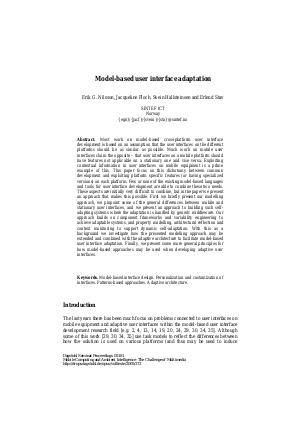Model-based user interface adaptation
Authors Erik G. Nilsson, Jacqueline Floch, Svein Hallsteinsen, Erlend Stav
-
Part of:
Volume:
Dagstuhl Seminar Proceedings, Volume 5181
Part of: Series: Dagstuhl Seminar Proceedings (DagSemProc) - License:
 Creative Commons Attribution 4.0 International license
Creative Commons Attribution 4.0 International license
- Publication Date: 2005-12-08
File

PDF
DagSemProc.05181.9.pdf
- Filesize: 198 kB
- 18 pages
Document Identifiers
Subject Classification
Keywords
- Model-based interface design
- personalization and customization of interfaces
- patterns-based approaches
- adaptive architecture
Metrics
- Access Statistics
-
Total Accesses (updated on a weekly basis)
0Document
0Metadata
Abstract
Most work on model-based cross-platform user interface development is based on an assumption that the user interfaces on the different platforms should be as similar as possible. Much work on mobile user interfaces claim the opposite – that user interfaces on a mobile platform should have features not applicable on a stationary one and vise versa. Exploiting contextual information in user interfaces on mobile equipment is a prime example of this. This paper focus on this dichotomy between common development and exploiting platform specific features (or having specialized versions) on each platform. Few or none of the existing model-based languages and tools for user interface development are able to combine these two needs. These aspects are initially very difficult to combine, but in the paper we present an approach that makes this possible. First we briefly present our modelling approach, we pinpoint some of the general differences between mobile and stationary user interfaces, and we present an approach to building such self adapting systems where the adaptation is handled by generic middleware. Our approach builds on component frameworks and variability engineering to achieve adaptable systems, and property modelling, architectural reflection and context monitoring to support dynamic self-adaptation. With this as a background we investigate how the presented modelling approach may be extended and combined with the adaptive architecture to facilitate mode l-based user interface adaptation. Finally, we present some more general principles for how model-based approaches may be used when developing adaptive user interfaces.
Cite As Get BibTex
Erik G. Nilsson, Jacqueline Floch, Svein Hallsteinsen, and Erlend Stav. Model-based user interface adaptation. In Mobile Computing and Ambient Intelligence: The Challenge of Multimedia. Dagstuhl Seminar Proceedings, Volume 5181, pp. 1-18, Schloss Dagstuhl – Leibniz-Zentrum für Informatik (2005)
https://doi.org/10.4230/DagSemProc.05181.9
BibTex
@InProceedings{nilsson_et_al:DagSemProc.05181.9,
author = {Nilsson, Erik G. and Floch, Jacqueline and Hallsteinsen, Svein and Stav, Erlend},
title = {{Model-based user interface adaptation}},
booktitle = {Mobile Computing and Ambient Intelligence: The Challenge of Multimedia},
pages = {1--18},
series = {Dagstuhl Seminar Proceedings (DagSemProc)},
ISSN = {1862-4405},
year = {2005},
volume = {5181},
editor = {Nigel Davies and Thomas Kirste and Heidrun Schumann},
publisher = {Schloss Dagstuhl -- Leibniz-Zentrum f{\"u}r Informatik},
address = {Dagstuhl, Germany},
URL = {https://drops.dagstuhl.de/entities/document/10.4230/DagSemProc.05181.9},
URN = {urn:nbn:de:0030-drops-3722},
doi = {10.4230/DagSemProc.05181.9},
annote = {Keywords: Model-based interface design, personalization and customization of interfaces, patterns-based approaches, adaptive architecture}
}
